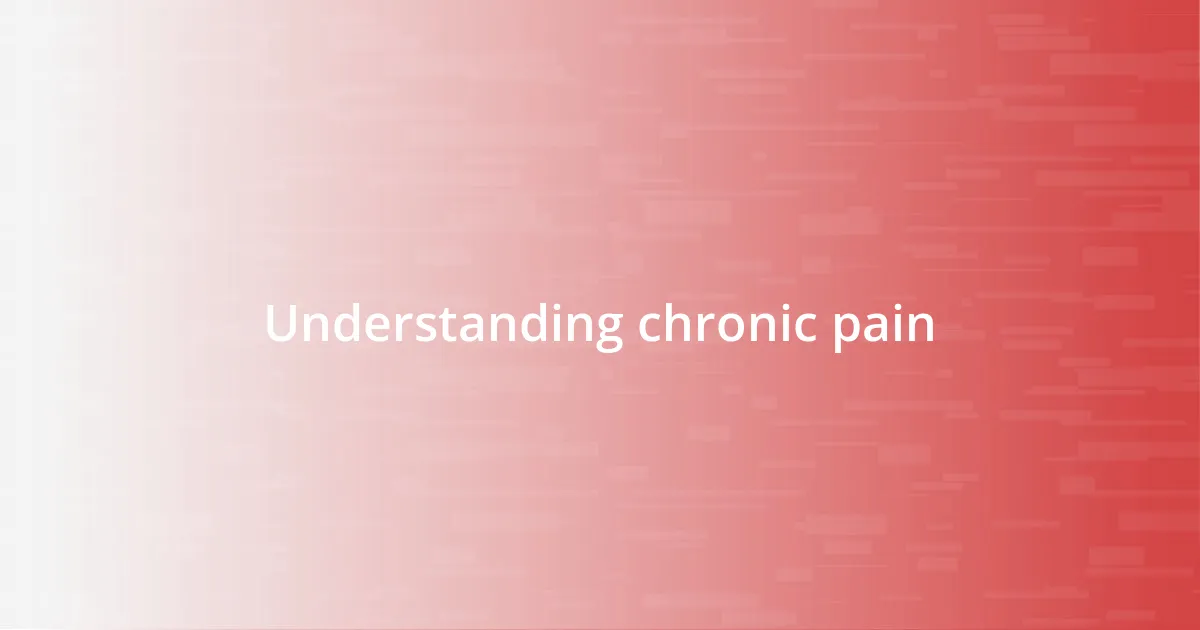Key takeaways:
- Chronic pain intertwines with emotions and mental health, requiring a holistic coping approach.
- Identifying personal pain triggers through methods like keeping a pain diary enhances pain management strategies.
- Daily coping strategies such as establishing routines, practicing mindfulness, and building community support significantly improve mental resilience against pain.
- Seeking professional help and exploring therapies provides essential guidance, empowering individuals in their pain management journey.

Understanding chronic pain
Chronic pain is more than just a physical sensation; it often feels like a relentless shadow. I’ve noticed that for many, including myself, the struggle isn’t just about the discomfort but also about the uncertainty it brings. Have you ever wondered how a simple movement can sometimes feel like a major hurdle?
It’s fascinating, and at times heartbreaking, how chronic pain can distort our relationship with our bodies. At my worst, when pain would flare up unpredictably, I felt like a prisoner in my own skin. Everything I did became a negotiation, a dance with my limitations. Can you relate to that constant balancing act between wanting to engage with life and needing to protect oneself from pain?
Understanding chronic pain requires recognizing that it’s often intertwined with emotions and mental health. I often find that when I’m feeling low, my pain intensifies, creating a vicious cycle. This connection can be puzzling; why does my mood seem so directly tied to my physical symptoms? I think that acknowledging this relationship is a crucial step in managing the experience, as it highlights the importance of a holistic approach to coping.

Identifying personal pain triggers
Identifying personal pain triggers is a vital step in managing chronic pain. Over time, I’ve learned that keeping a pain diary can be immensely helpful. By jotting down when the pain peaks and what I was doing or feeling at that moment, patterns began to emerge. For instance, I realized that certain weather conditions, like damp or cold days, always exacerbated my discomfort. It’s like a personal puzzle where each piece sheds light on my condition.
Here are some common triggers that I’ve identified and that may resonate with you:
- Stress—High-pressure situations often lead to increased pain levels for me.
- Physical activity—While exercise is essential, overdoing it can trigger flare-ups.
- Diet—I’ve noticed certain foods, like dairy and processed sugar, can worsen my symptoms.
- Sleep—A restless night can leave me feeling achy the next day.
- Emotional state—When I’m feeling anxious or sad, my pain tends to spike.
By acknowledging these triggers, I’ve gained more control over my pain management strategies. Exploring my personal relationship with triggers has been pivotal in navigating the ebbs and flows of chronic pain.

Daily coping strategies for pain
When it comes to daily coping strategies for chronic pain, I’ve found that establishing a consistent routine can make a significant difference. For me, incorporating gentle stretching and mobility exercises each morning not only helps with flexibility but also sets a positive tone for the day. Have you ever noticed how those small acts of self-care can create a ripple effect on your emotional state? I believe that starting the day with intention can help spark resilience against the pain that often follows.
Another strategy I rely on is mindfulness meditation. It’s remarkable how dedicating just a few minutes to mindfulness can create a sense of calm and grounding amidst the chaos of pain. I often visualize myself in a safe space, focusing on my breath and allowing the sensations of pain to coexist without judgment. This practice doesn’t eliminate the pain, but it drastically changes my emotional response to it. It’s about changing the narrative—do you ever find that shifting your perspective can ease your mental burden?
Finally, I lean on community support as a powerful tool. Connecting with friends or support groups who understand the battle can provide a comforting sense of solidarity. Sometimes, just sharing a laugh or exchanging tips can uplift my spirits. I remember a time when I shared my frustrations with a close friend, and their understanding reassured me that I wasn’t alone in this journey. It’s interesting how the human connection can foster healing, isn’t it?
| Strategy | Description |
|---|---|
| Consistent Routine | Incorporating gentle exercises each morning to promote flexibility and positivity. |
| Mindfulness Meditation | Practicing mindfulness to change the emotional response to pain without eliminating it. |
| Community Support | Connecting with understanding friends and groups for emotional solidarity. |

Integrating mindfulness and meditation
Mindfulness and meditation have been transformative tools in my journey with chronic pain. I still remember the first time I sat down in a quiet room, took a deep breath, and allowed myself just to feel. At that moment, I realized I wasn’t fighting the pain; rather, I was making space for it. Do you ever find that simply acknowledging your feelings can provide a sense of relief? It’s almost as if giving my pain permission to exist diminishes its power over me.
In my experience, integrating these practices into my daily routine started as a struggle. I had a million thoughts racing through my mind, making it challenging to focus. But over time, I discovered the beauty of guided meditations. They offer a gentle pathway into mindfulness, helping me to anchor myself in the present moment. Each session feels like a mini-vacation from pain; I allow myself to drift into that calm state. I can vividly recall one afternoon, sitting cross-legged, repeating a mantra that resonated with my soul. It was during those moments that I felt a connection not just to myself, but to anyone else wrestling with pain. Isn’t it incredible how shared experiences can create bonds, even if we’re alone in our thoughts?
It’s fascinating how my perspective has shifted through mindfulness. What once felt like an all-consuming burden has transformed into a part of my story. The other day, while practicing mindfulness, I visualized my pain as a wave—sometimes crashing, sometimes retreating. This imagery reassured me that, like all waves, it’s temporary. Have you ever thought about how powerful your imagination can be in this fight? Adopting this mindset helps me navigate the ups and downs with greater ease. Integrating mindfulness hasn’t eradicated my pain, but it has undoubtedly changed the way I coexist with it.

Using physical activity effectively
Using physical activity effectively has been a game-changer for me. I’ve discovered that even when pain seems daunting, engaging in low-impact activities like walking or yoga can actually help reduce stiffness and increase my energy levels. Have you ever gone out for a short walk and returned feeling just a bit lighter? It’s truly amazing how something as simple as moving your body can shift your mindset, even if just for a moment.
I still remember a day when my pain felt overwhelming. Instead of succumbing to it, I decided to put on some soft music and stretch gently on my mat. I approached the stretches slowly, tuning into how my body felt in each position. The experience felt almost meditative—there I was, allowing my body to move without judgment. That day taught me that physical activity doesn’t have to be intense to be effective; sometimes, it’s about listening to what my body truly needs. Have you considered how small movements can evoke powerful shifts in our emotional landscape?
On days when even sitting feels unbearable, I turn to isometric exercises. These are movements where I engage my muscles without actually changing their length, like holding a plank. I recall one afternoon, feeling particularly heavy with pain, I challenged myself to hold that plank for just a few extra seconds. Surprising my own limits, I found that my determination outweighed the discomfort. It was as if my body whispered a reminder: I am capable of more than I think. Isn’t it empowering to realize that within our struggles, there lies an opportunity for strength?

Building a support network
Building a support network has been essential in my journey with chronic pain. Initially, I struggled with a sense of isolation, feeling like no one could understand what I was going through. Reaching out to friends and family, however, opened new doors for sharing my experiences. I’ll never forget the day I confided in a close friend about my struggles. Instead of feeling dismissed or misunderstood, I received the empathy and encouragement I desperately needed. Have you ever shared your burdens and felt an unexpected weight lift off your shoulders?
As I continued to build this network, I found that attending support groups was incredibly beneficial. It was a bit daunting at first, walking into a room full of strangers, but I was pleasantly surprised. I soon discovered that everyone had their own unique stories and coping strategies. It was astonishing how sharing our experiences could create a sense of community. I vividly recall a conversation with someone who had been battling similar challenges for years. Their honesty made me realize that even in our darkest moments, we can find solace in understanding one another. Isn’t it rejuvenating to connect with others who genuinely get it?
Moreover, I’ve come to appreciate the value of online communities. Forums and social media groups have offered me a space to connect with fellow chronic pain warriors from across the globe. I remember posting a particularly tough day, and the outpouring of support was overwhelming. People from different backgrounds chimed in, sharing tips, advice, and simply validating my feelings. It reminded me that even on the loneliest days, I am part of something much bigger. Have you explored the power of virtual connections? They can be just as impactful as face-to-face interactions, often providing a lifeline when we need it most.

Seeking professional help and therapies
Seeking professional help for chronic pain has been a pivotal step in my journey. When I first visited a pain management specialist, I felt hopeful yet nervous—would they really understand what I was experiencing? This first appointment opened my eyes to a spectrum of treatment options I had never considered before. Have you ever felt a little lost, only to find guidance that truly resonates with you?
I’ve tried various therapies, from physical therapy sessions that feel like a blend of massage and personal training to acupuncture, which was surprisingly calming. I remember one session where the therapist gently explained each technique, showing me that pain relief can be a collaborative process. It felt empowering to know that I wasn’t in this alone; there was a team working alongside me. Have you ever experienced that sense of collaboration in your own healing journey?
Medication, too, has been part of my route to recovery. Initially, I was hesitant to rely on pills, fearing dependency. But after a candid discussion with my doctor, I learned about the different types available and how they could help manage my pain. My perspective shifted when I realized that medication wasn’t just about numbing my discomfort; it was about enabling me to engage more fully with life. Have you had open conversations with your healthcare provider that changed how you viewed your options?















